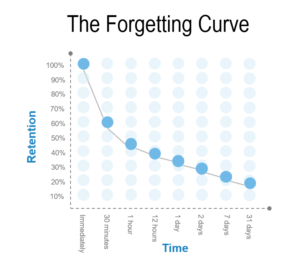
24 Sep How to Make your Sales Training Stick: 4 Mechanisms for Reinforcement
Pop quiz. What percentage of knowledge and skills is forgotten within 90 days after sales training?
- a) Approx. 25%
- b) 60% – 75%
- c) 85% or more
If you’re like most people, you probably chose (b) 60-75%. However the correct answer is actually (c) 85% or more.
Most sales training programs fail to produce the intended results. Trainers, managers, or vendors deliver (what appears to be) great sales training, but in the end behavior does not change. Lack of post-training reinforcement is one of the biggest reasons why training misses the mark.
Rather than viewing sales training as a single event, training must be viewed as part of a holistic approach to change management. This approach should consist of:
- Pre-workshop consultation with key stakeholders before the training event
- An interactive workshop that focuses on the application of skills to real-life situations
- Post-workshop reinforcement to facilitate the adoption of new behaviors
To make sure your training efforts are getting a positive ROI, incorporate these four reinforcement mechanisms after the training event:
1. Action Planning
Completing an action plan at the end of a training event builds a bridge from learning to doing. Treat the action planning process as a firm commitment as to what the salesperson will do differently.
To be effective, the plan should contain no more than 3-5 actions. They should be specific in nature, however they should take time to implement. Each action should also have a deadline for completion. Action plans should be unique and customized to each salesperson and their development goals.

2. Online Reinforcement
Reinforcing content after sales training is critical to the change process. Over 100 years ago, German psychologist Hermann Ebbinghaus performed a series of experiments to understand how memory works. From his research, he came up with the Forgetting Curve. The Forgetting Curve illustrates how quickly we forget new information after we first learn it.

During his research, Ebbinghaus discovered that we can fight off the Forgetting Curve by constantly reviewing new knowledge over particular intervals. By practicing spaced repetition, we force our brain to retrieve and recall information – thus building muscle memory.
What are the implications? Make sure sales training is followed up with plenty of online reinforcement. This can take the form of videos, rapid learning modules, downloadable tools, quick reference guides, or e-Learning courses.
3. Sales Coaching
Coaching helps facilitate the adoption of newly learned knowledge and skills into real-life situations. By providing ongoing coaching, salespeople will get the structure, accountability, and feedback they need to help them adopt new behaviors. Without the proper coaching, salespeople are at a high risk for relapsing back into their old familiar habits and ways of doing things.

4. Interim Checkpoints
To accelerate change, set up interim checkpoints throughout each week. Have each salesperson check in with you (or check in with one another) to discuss progress. This helps ensure there is continuous momentum. It also helps maintain focus and develops accountability.
By having interim checkpoints, it gives salespeople the opportunity to demonstrate their level of commitment in making the necessary changes.
Acquiring knowledge is important. However, its even more important to take that knowledge and turn it into commercial opportunity. By focusing on post-workshop reinforcement, you’ll see behavior change. This leads to higher levels of motivation, an increase in training efficiency, and a much greater ROI.
Having a reinforcement strategy is a powerful tool for generating long-term sustainable change. If you’d like further insight, contact us to learn more.


